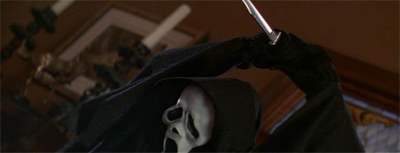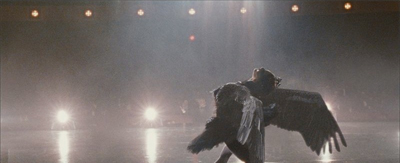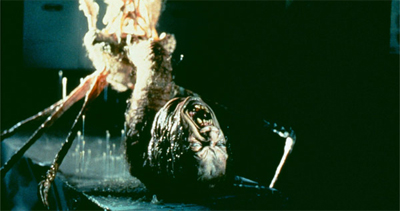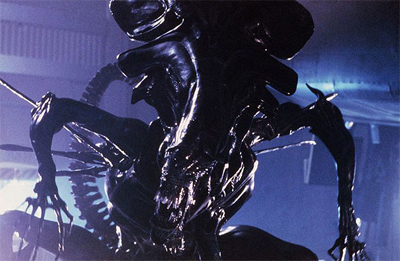D’you know what would have been scarier than nothing?
What?
Anything!
– Bart and Lisa discuss Edgar Allen Poe’s The Raven, The Simpsons
The week before last, in reviewing Insidious, I made the observation that director James Wan made the mistake of “showing too much” in his horror film, and that movie itself suffered because it didn’t show any restraint in how it handled its creatures and monsters. The always wonderful Justin, in fairness, called me on my assertion correctly – who ever stated it was a rule that horror films can show too much? Surely it’s possible to show as much of something as you might want, provided you have enough talent and skill to do it well? Surely showing too much only becomes a problem when you aren’t skilled enough to deliver something genuinely terrifying?
Or is it something more primal? Is what you don’t see scarier?
Don’t get me wrong. I am a wuss. I freely confess that I am a wuss. My aunt and uncle are horror junkies, and – during the recent spate of torture and gore-driven horrors (basically, the later Saw films) – I am the person in the house who spends most of my time wincing and squirming in my seat. Still, I don’t think I’d describe any of the violence and physical gore that I’ve seen in films like The Texas Chainsaw Massacre remake or Hostel as “terrifying” – I’d sooner use the adjectives “uncomfortable” and “disgusting.”
However, it isn’t films like that which ever gave me nightmares, or led me to sit awake at night staring at the ceiling in my room. Truth be told, and this is something entirely personal, it was concepts that scared me. A Nightmare on Elm Street terrified the young impressionable version of me, as I faced the possibility of something hunting and killing me in my sleep. Although Sadako’s appearance from Ringu was disturbing (especially the nails and the way she moved), it was the very idea of something coming out of a television or a screen which led me to unplug my television that night. It’s the ideas themselves which are unsettling, rather than the physical gore or violence attached to them. Even with Black Swan, the most terrifyingly uncomfortable moments were spent keeping the audience in anticipation of what horror might happen rather than what actually did.
Of course, horror is inherently subjective. Being honest, I look at those two examples and think of what a wimp I must have been to be unsettled by those ideas, but they stay with me. If you ask me to pick a truly classic horror film, I’m going to pick something like The Shining – and, again, it’s down to core ideas (the notion of a father preying on his family, rather than any of the haunted hotel stuff). I have a soft spot for Alien, which was notably restrained in portraying the eponymous creature (in some scenes, it’s fairly obviously a guy in a suit).
I don’t think, though, that this in inherently subjective thing. I think, broadly speaking, a lot of people would agree. It’s not necessarily what you see that scares you, but the idea itself. That’s why, I reckon, things tend to scare us and stay with us when we’re younger – when we don’t know enough about the world to know such things are impossible. If you asked people to point to the scariest movie creations ever created, I reckon that the Child Catcher from Chitty Chitty Bang Bang would make the list. That’s a family favourite film, but it’s easily one of the creepiest things I’ve ever seen, if only because the concept was so scary to me as a child.
If there are any horror fans out there, I can’t recommend Stephen King’s Danse Macabre strongly enough. King talks about a lot in the book, from his theories on writing, to aspects of his life, but also about his theories on horror. In particular, King suggests that there are three types of fear that a horror film can aim to subject its audience to: terror, horror and revulsion. The last one listed there is identified by King as the weakest form, and one to be used when a writer feels they can’t generate the other two (he does concede he uses it from time to time). It’s an almost physical reaction of disgust to something, and it seems to be the type of reaction that most modern horror films go for.
I’m not judging this approach. I will concede that I am easy to shock and disgust. However, I think that revulsion is perhaps the most volatile state of fear that a movie can create in an audience, and I think this is where “showing too much” comes into play. Revulsion is about showing us something that seems inherently wrong or unnatural – something so horrible that our reaction isn’t one of fascination or curiosity, but outright disgust.
However, showing us too much of something has the effect of familiarising ourselves with it. The more we see of something, naturally the less unknown it remains. Gradually, it becomes “known” and familiar. If you ask me, this sort of process is at the root of the decay which turned characters like Jason and Freddie and the Xenomorphs into jokes – audiences simply saw too much of them to feel anything approaching fear. Naturally, this occurs over the space of film franchises, but I also firmly believe it happens on a “micro” level too.
Once we get a look at a creature and know for sure, for example, that it has eyes or a head (or even that it’s dodgy CGI), it becomes somewhat less unknown or unknowable. It’s gone from being something we can’t understand or relate to and becomes something that vaguely resembles something we’ve dealt with before. Allowing the camera to linger too long on a strange shape, for instance, allows us to determine that it’s shaped like a male human, or invites us to marvel at the special effects rather than being jolted upright.
I also think that, perhaps, there’s something about our survival instincts at play as well. Our initial response to something we don’t recognise is primal and instinctual. Our ancestors recoiled when they found a snake in the mud, even though they didn’t know what it was. That which was unknown was, on some level, assumed immediately to be dangerous – until it was proven safe. It’s a reasonable evolutionary safeguard, and I think it still plays out in our subconscious. I think that showing us a quick flash of something, or “just enough” catches those primal fears off-guard, before the rational mind can jump in and tell us that it’s a special effect or a guy in a suit.
Of course, there are those who can show us almost everything and still disturb us. David Cronenberg comes to mind, with his “body horror” films like The Fly. There’s no denying that some of the truly classic special effects work within the horror genre deserves mention, but how much of that truly scared us or gave us nightmares? Undoubtedly, some did – but I’d argue that it was the minority, the exception that proved the rule. For every one example which worked, I imagine there were ten to twenty films that were let down when their monsters either seemed too banal or too fake for their audiences – in either case, showing less might have made the movie more intense…
Filed under: Movies | Tagged: arts, Child Catcher, Chitty-Chitty Bang-Bang, david cronenberg, film, horrifying, horror, Horror film, James Wan, monsters, Movie, Movies, nightmares, saw, scary, scary movies, shining |

























I think your thoughts on the subject are very close to mine. Kudos, as well, for bringing up SK’s Danse Macabre book. Still a superb critique on the genre and writing. Excellent essay, Darren. Thanks for this.
Thanks, much appreciated. And it is great little book, isn’t it?
Great post Darren. For me personally, it all comes down to identification and a sense of reality. When we imagine scary monsters lurking around a corner, it seems real and terrifying. Once I see the monster, there is a sense of distance created. At this point, the amount of terror I feel is related to how much I’m invested in the characters themselves.
This is why I will always defend the first Hostel movie. As a college age guy, I completely identified with the main character. His dread was my dread. Most of the terror of Hostel comes from the anticipation of slowly descending into the dungeon of torture. One of the most terrifying scenes in the movie is when one of the “customers” of the hostel is trying to decide which torture instrument he would use. While you always need SOME kind of payoff (a good payoff is hard to achieve), it is true one’s imagination is the most terrifying instrument a filmmaker can exploit.
Thanks Justin, and you’re right… I always found the anticipation to be the scariest part of any horror like that. I think I remember that bit in Hostel and the bit with the woman and the sycthe and the bath. It’s the moments before anything horrible actually happens that are the worst.
I spot with mine eyes a still used for a CC. I demand mentions.
Kidding.
I completely agree with you. Showing too much diminishes the scares. That’s why I consider ALIEN to be a horror flick, and ALIENS to be an action flick.
Granted it can vary. The ending bloodbath in the first SCREAM was consistently terrifying, even though the killer had a lot of screen time, because it seemed completely plausible, and, like has been said, when it’s plausible, it’s far more terrifying. That’s why 28 DAYS LATER… is still, in my opinion, one of the scariest movies ever made.
Because Zombies are very plausible… I kid, I kid.
But seriously, that’s the reason I’ve never been a fan of zombies. They never seemed scary because they seemed so removed from reality for me. I guess that’s the subjective aspect, though.
Well, 28 Days Later… was different because the setup for the zombies was believable. The whole virus thing is way more scary than the undead pushing their way out of their own graves.
Also, the “zombies” in the movie weren’t technically dead, just infected. Also, more plausible, and way scarier. Plus, they could run.
Was it Cameron who suggested Aliens was his attempt at a Vietnam film? I’d agree – I’d class it more as action than horror.
I agree with the spirit of the point here, but I don’t know if I necessarily believe this to be true applied universally to all movies with an iconic killer or monster is central to the film’s conceit. Showing off the xenomorphs in the Alien films makes sense; they strike such a fine balance between familiarity and physiologically impossible that seeing them in full view just makes them scarier. How do you reconcile something that you know shouldn’t be possible?
On the other hand, before slasher movies became slasher movies and we knew them as giallo movies, the killer was a mystery and showing them off was a bad idea. Nowadays, people watch slasher movies for the slashers, so we naturally expect to see them in full view.
But then you take something like Jaws, and it becomes quick to see how wrong things can go if you show off the central monster too much. I can’t imagine that that film be half as iconic today if we saw more of the shark.